Onions (Allium cepa) are well suited to grow in Saskatchewan's climate and soils. Both the bulbs and tops are edible, depending on the type grown.
Soil Conditions
Onion seedlings are fragile at emergence. A well-worked seedbed and light textured soils are essential to proper emergence. The ideal soil for onions is well-drained but also has good water-holding capacity, as onions are shallow-rooted. Onions will mature earlier on lighter, sandy soils than on heavier soils. Onions can grow on a range of soil pH, and do well on peat and muck soils.
Seed Treatment
Seed costs for onions have increased over the last 10 years due to improved quality and the increasing use of hybrid varieties. In the past, growers used to seed thick to compensate for poor seed quality, improper seed bed preparation or losses due to disease or insects. Now crops are precisely spaced and seeded – this necessitates use of a seed treatment to insure that the crop emerges. Consult your local seed representative to get more information on seed pelleting and seed application of fungicides.
Varieties
There are three main types of onions:
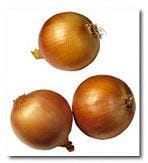
University of Illinois Extension)
Dry – are the most common type of onion. Dry onions have a variety of shapes, ranging from globular to oval and flattened on the top and bottom. Spanish onions are a type of dry onion.
Sets – are produced when shallots or multiplier onions are sown very close together. Due to this dense seeding, mature bulbs will be small. Sets are grown mostly for home-gardeners, who plant these bulbs to shorten maturity time for the following crop.
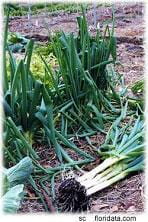
(Photo courtesy of
Floridata.com)
Bunching – are sown thicker than dry onions and are harvested before they form bulbs. They are also referred to as scallions.
Results and recommendations can be found on the University of Saskatchewan Plant Sciences Department website.
Seeding
Onions are generally planted as soon as the field can be worked. Row spacing is normally 36 to 46 cm (14 to 18 inches), depending on the type of cultivation equipment used. Seeding density depends on the type of onion being planted:
- Dry onions – 2.2 to 2.9 kg/ha (2 to 2.5 lbs/acre)
- Sets – 50 to 78 kg/ha (45 to 70 lbs/acre)
- Bunching onions - 11.2 to 27.9 kg/ha (10 to 25 lbs/ac)
- Seed depth should be 1.3 to 1.9 cm (½ to ¾ inch) deep.
Most onions are direct-seeded; however, some growers transplant to grow the larger, longer-season Spanish-type onions. Sets are commonly used by hobby gardeners who want to get early season onions. Sets are grown very closely, thus keeping their size small as they reach harvest. As expected, the price for sets is higher than regular direct-seeded seeds.
Hilling
Onion bulbs emerge from the soil as they grow. Lightly hilling bulbs will reduce the amount of sunburn to the onion, will help maintain moisture close to the roots and will reduce weed competition.
Fertility
Always start your fertility program with a soil test. Random soil samples should be collected from the entire field that you intend to plant. Due to climactic conditions, differing cultural practices, varying soil conditions and other situations, the crop's response to a fertility regimen may vary from region to region.
Onions have a limited and shallow root system; therefore nitrogen, phosphorus and potassium levels near the soil surface must be relatively high. Many growers band the fertilizer five to eight cm (two to three inches) below the seed for the most efficient uptake of the fertilizer.
Dry onions
- 40 to 80 kg/ha nitrogen (36 to 71 lbs/acre)
- 120 to 160 kg/ha phosphate (107 to 143 lbs/acre)
- 130 to 170 kg/ha potassium (116 to 152 lbs/acre)
- * reduce P rate by 1/5 if side-banded
- * reduce K rate by ½ if side-banded
Sets and Pickling Onions
- 20 to 50 kg/ha of nitrogen (18 to 45 lbs/acre)
- 120 to 160 kg/ha of phosphate (107 to 143 lbs/acre)
- 130 to 170 kg/ha of potassium (116 to 152 lbs/acre)
- * reduce P rate by 1/5 if side-banded
- * reduce K rate by ½ if side-banded
*** All fertilizer should be either broadcast or side banded. The seed could be exposed to burning if fertilizer is placed directly on the seed.
Irrigation
Onions are a shallow-rooted crop; therefore they require frequent but thorough irrigation to achieve maximum marketable yields. Thick necks on bulbs can result if water level is too low. To promote maturity, water should be stopped 14 to 21 days before undercutting occurs. This will allow for maturing and ripening of the bulbs and die-back of the tops.
Sprout Inhibition
Maleic hydrazide (Royal MH 60) is used to limit sprouting in stored onions. Maleic hydrazide is applied in the field at least two weeks before harvesting. Bulbs should be mature and have five to seven green leaves to ensure absorption of the maleic hydrazide. This treatment will also help control volunteer onions the following year. Volunteer onions carry diseases over-winter.
Harvesting
Dry onions have reached maturity when the tops have fallen over and started to dry. It is important that the onion mature before storage. Otherwise, neck rot will enter. Once the tops are beginning to dry, undercutting the roots will speed maturity.
Onions are best harvested when no rain is expected for a few days. Growers may choose to undercut the roots and windrow a few rows or beds into one. This will allow the tops and outer scales to dry and cure in the field. If using irrigation, watering should be stopped 14 to 21 days prior to undercutting the roots. Sometimes dried tops are pulled from the bulbs when the undercutting occurs. It is important, though, to make sure that the tops are completely dried to prevent neck rots.
Onions will begin to freeze once soil temperatures fall below -1°C (30°F). Onions can endure temperatures as low as -5°C (23°F) with little damage, but they must be allowed to thaw at 4°C to 5°C (39°F to 41°F) prior to handling. Handling during thawing can wound the onion, which would accelerate breakdown. More severe freezing results in a water-soaked appearance to the scales, which may be yellow or grey. Entire scales may begin to break down while other nearby scales may remain intact and unharmed.
Storage
Onions should be stored at 0°C (32°F) and at 65 to 70 percent relative humidity. Temperatures above 0°C (32°F) will cause the onion to sprout. This sprouting will lead to bulb rot and increase moisture loss. Relative humidities exceeding 70 percent will cause the onion's roots to sprout. Air movement through the pile is beneficial to reduce disease spread that could occur from a wet pile.
If onions are harvested partially green, they must be artificially cured before attempting to store the crop. Curing is achieved by holding the onions at 35°C (95°F) with plenty of ventilation for two weeks. This will help to kill any neck rot organisms that may be present. This temperature should be slowly increased if the onions are immature to ensure minimal heat damage is incurred.
The length of time an onion may be safely stored will depend on the degree of maturity and the variety, which will determine its dry matter content. Yellows are the best storage onions, followed by reds, whites and then Spanish onions. The more pungent the onion (i.e. yellows and reds), the longer it usually can be stored. The sweeter it is, (i.e. Spanish), the poorer storage onion it will be.
Grades
Onions can be sold in Canada under the following grades: Canada No. 1, Canada No. 1 Pickling and Canada No. 2.
The following outlines the Canada No. 1 Grade standard:
- Size requirement of 2 to 8 cm (¾ inch to 3 inches) when a size range is not declared on the bag or tag, or if the package is not transparent
- Onions must be mature, that is the neck of the onion has to be completely dry and the onion does not yield to moderate pressure. Onions sold before September 16th each crop year have different grades that are softer than this.
- Injury of any kind cannot penetrate through more than one scale of the onion
- Sunburn cannot be visible on more than 10 percent of the onion
- Freezing injury cannot total more than one complete outer scale of the onion
*** For a complete grade standards, consult the Canadian Grade Compendium Volume 2 included in the Safe Food for Canadians Act.
Pest Problems
Diseases
Neck Rot – or botrytis (Botrytis aclada) is one of the most common storage diseases of onions – both in the field and in storage. Following attack by this fungus the neck of the onion becomes soft, and the rot moves into the bulb.
Control includes: eliminate cull piles, increasing distance between onion fields, ensuring bulbs have been properly cured and dried down and stopping irrigation three weeks prior to harvest. Onions that are bruised or have thick necks should be culled before storage.
Downy Mildew – (Peronospora destructor) shows its presence as a velvety-growth of the mycelium on the green foliage. Diseased leaves turn yellow after a few days and eventually die. The fungus can over-winter in the bulbs or sets, or on other host plants. The fungus infects new leaves as they emerge, causing them to be a paler green colour than healthy plants.
Control of downy mildew includes destruction of any cull piles. No onions should be left near fields to be planted to onions the following year. Do not rotate fields with crops that are susceptible to or could pass on downy mildew. These include beet, chard, spinach, broccoli, Brussels sprout, cabbage, cauliflower, radish, rutabaga, lettuce, chicory, endive, leek, garlic, peas, beans and rhubarb. A number of products are registered for control of Downey Mildew in onions.
Insects
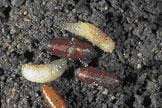
© 1996 Regents, University of
California Photo by Jack Kelly Clark
Onion Maggot – (Delia antiqua) is the most serious insect pest in onions. Onion maggots damage both the roots and more importantly the bulbs. Onion maggots cause the greatest damage in their first larval stage, which occurs when the plants are very young. The maggot over-winters in the soil.
Control includes: disposing of cull piles or volunteer onions. Second and third generation onion maggots prefer injured or dying tissue. Avoid damaging or bruising any of the crop during harvest. Onion maggot flies can be controlled chemically. For a list of registered products please contact the Provincial Vegetable Specialist.
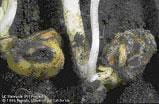
1996 Regents, University
of California
Photo by Jack Kelly Clark
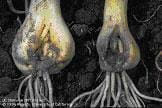
1996 Regents, University
of California
Photo by Jack Kelly Clark
Weeds
Onions do not compete well with weeds. Competition from weeds early in the season will slow both emergence and early growth. Weeds can be controlled with shallow tillage to destroy any weed seedlings. Hilling will also help control the weeds growing between the rows. Weeds can also be controlled chemically. For a list of herbicides registered for use on onions, please contact the Provincial Vegetable Specialist.
